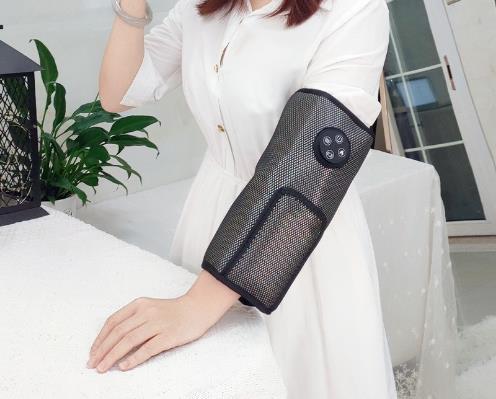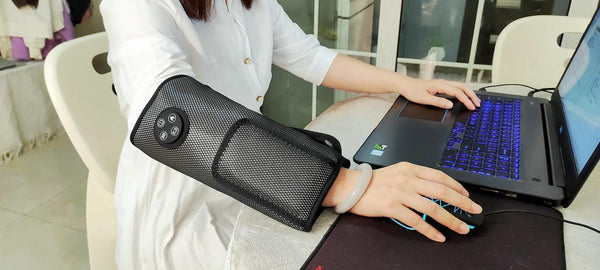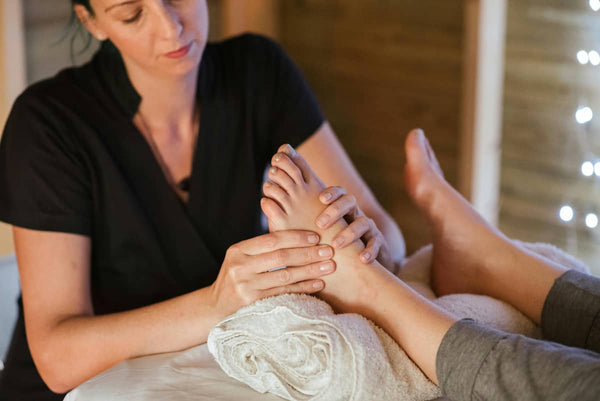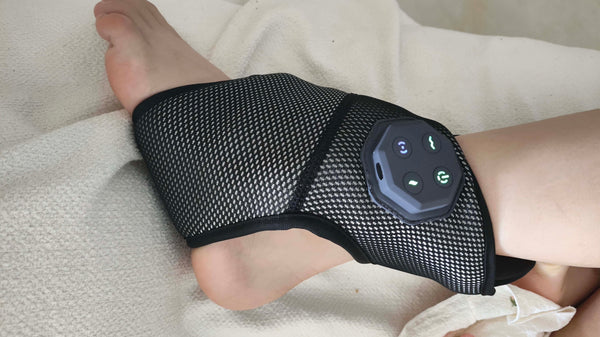 Ah, the dreaded stiff neck and shoulders! You know the feeling, right? That nagging ache that turns your head movement into a creaky old gate, especially after a long day hunched over a desk. It's a tale as old as time, or at least as old as office chairs. Did you know that roughly 7 out of 10 adults experience neck pain at some point? For office workers, it's practically a badge of honor, albeit a painful one. But fear not! While some folks might tell you that neck and shoulder massagers are the enemy, I'm here to tell you they can actually be a friendly ally in your quest for comfort, if you know how to use them wisely. Let's unlock the secret to smart, soothing relief!
Ah, the dreaded stiff neck and shoulders! You know the feeling, right? That nagging ache that turns your head movement into a creaky old gate, especially after a long day hunched over a desk. It's a tale as old as time, or at least as old as office chairs. Did you know that roughly 7 out of 10 adults experience neck pain at some point? For office workers, it's practically a badge of honor, albeit a painful one. But fear not! While some folks might tell you that neck and shoulder massagers are the enemy, I'm here to tell you they can actually be a friendly ally in your quest for comfort, if you know how to use them wisely. Let's unlock the secret to smart, soothing relief!
Why Do My Shoulders Hurt After a Massage? Unpacking the Knotty Truth
It's a common question, and frankly, a valid concern: "Why do my shoulders hurt after a massage?" If you've ever felt worse after using a neck and shoulder massager, you're definitely not alone. Often, the culprit isn't the massage itself, but rather the intensity or an underlying issue. Think of your neck and shoulders as a delicate, intricate system of muscles, nerves, and bones. When these areas are subjected to excessive force, whether from a too-vigorous massage or prolonged poor posture, they can get quite grumpy. This grumpiness can manifest as muscle soreness, inflammation, or even a feeling of increased stiffness – quite the opposite of what you're aiming for!
From a physiotherapist's perspective, this post-massage soreness, especially with an electric neck and shoulder massager, often points to overstimulation of already tense muscles. It’s like trying to untie a knot with a sledgehammer instead of gentle, persistent tugs. Your muscles respond to trauma by tensing up even more, trying to protect themselves. This can lead to that redness and inflammation some users reported, making an already stiff neck feel even heavier. Understanding this mechanism is the first step towards using a neck and shoulder massager effectively and safely. For instance, sometimes what feels like a "good" deep massage can actually be irritating nerve endings if not applied correctly.
- Muscular Overload: Too much pressure can cause micro-tears in muscle fibers, leading to soreness and inflammation.
- Nerve Irritation: Direct pressure on superficial nerves can cause radiating pain or numbness.
- Inflammatory Response: The body’s natural reaction to perceived injury, resulting in redness and swelling.
- Underlying Issues: Pre-existing conditions like cervical disc issues or arthritis can be aggravated by strong massage.
Is Massage Good for Neck and Shoulder Pain? Exploring Effective Therapies and Gentle Techniques
So, the big question: "Is massage good for neck and shoulder pain?" Absolutely, a resounding YES – when done correctly! The trick is knowing which therapy suits your specific needs and how to apply it without causing more grief. Think of it like cooking: the right ingredients (techniques) in the right amounts (intensity) create a masterpiece, while too much heat or the wrong spice can spoil the dish. As a physiotherapist, I often guide patients through a spectrum of massage therapies, from self-care methods to professional interventions.
When it comes to using a neck and shoulder massager at home, the key is understanding the difference between deep tissue work and gentle relaxation. Many modern devices, especially those offering deep tissue massage settings, can be quite powerful. While these can be fantastic for breaking down stubborn knots in the right hands (or rather, on the right body part!), they need to be used with extreme caution, particularly around the delicate neck area. Remember, you're aiming for relief, not a wrestling match with your muscles!
Self-Massage & Gentle Tools: Your Daily Dose of TLC
 Principle: Gentle stimulation improves circulation, relaxes superficial muscles, and calms nerve endings without causing irritation. It's about coaxing, not conquering, your stiff spots. This is where a neck and shoulder massager with heat can truly shine, as warmth significantly aids muscle relaxation.
Principle: Gentle stimulation improves circulation, relaxes superficial muscles, and calms nerve endings without causing irritation. It's about coaxing, not conquering, your stiff spots. This is where a neck and shoulder massager with heat can truly shine, as warmth significantly aids muscle relaxation.
Suitable for: Office workers with general stiffness, those experiencing mild stress-related tension, or individuals seeking daily preventive maintenance. Think of it as your daily stretching routine for your muscles. Just ensure the device you choose for massage for shoulder areas offers variable intensity settings.
Effectiveness: Regular, gentle application can significantly reduce daily tension, improve range of motion, and prevent stiffness from escalating. Studies suggest that consistent, low-intensity massage can lead to a 20-30% reduction in perceived neck pain over several weeks. Remember, slow and steady wins the race when it comes to muscle relaxation.
- Manual Self-Massage: Using your own fingers or a tennis ball against a wall for specific trigger points. This gives you direct control over pressure.
- Vibrating Massagers (Low Setting): These are fantastic for stimulating blood flow and easing surface tension. Look for devices with multiple speed settings.
- Heat Therapy Combined Massagers: A neck & shoulder massager with heat is a game-changer. The warmth penetrates deeply, relaxing muscles before the massage even begins.
- Pillow-style Massagers: Often gentler than handheld percussive devices, these allow you to lean into the massage rather than force it.
Professional Deep Tissue Massage & Physiotherapy: When You Need the Big Guns
Principle: Targeted techniques to release chronic muscle knots (trigger points) and fascial restrictions, often involving sustained pressure or specific strokes. This kind of deep tissue massage often requires a trained hand to precisely locate and release problem areas without causing undue discomfort or injury. It's a more intense intervention aimed at deeper layers of muscle.
Suitable for: Individuals with persistent, severe muscle knots, chronic pain, restricted movement, or those recovering from specific injuries. If your neck feels like a block of concrete, or you have pain radiating down your arm, a professional might be your best bet.
Effectiveness: Highly effective for releasing stubborn tension and improving long-term function. Clinical trials show that regular professional deep tissue massage can reduce chronic neck pain by up to 50% for some individuals, and improve functional ability significantly. The trained eye of a physiotherapist can also identify underlying issues a massager might just mask.
How to Massage Neck and Shoulders Smartly: Maximizing Relief and Minimizing Risks
Now for the million-dollar question: "How to massage neck and shoulders?" It's not just about turning on the machine; it's about smart usage! The goal is to provide soothing relief, not to win a battle against your own muscles. Here are some physiothearapist-approved strategies to get the most out of your neck and shoulder massager while avoiding those pesky negative side effects.
First off, remember the "less is more" mantra. Start with the lowest setting on your neck and shoulder massager. You're aiming for a comforting sensation, not a jarring one. A common mistake I see is people pressing the massager down too hard. Let the machine do the work! If you have a neck & shoulder massager with heat, always activate the heat first to warm up the muscles. This makes them much more pliable and receptive to massage, reducing the risk of irritation. Think of it as pre-heating your muscles for maximum relaxation.
My Top Tips for Smart Massage for Shoulder & Neck Relief:
- Start Gentle & Go Slow: Always begin with the lowest intensity setting. If it feels too strong, ease off or adjust your position. A massage session should feel relaxing, not like a test of endurance.
- Move It Around: Don't keep the neck and shoulder massager in one spot for too long. Keep it moving across the muscles. Spending more than 1-2 minutes on a single small area can lead to irritation and soreness.
- Listen to Your Body: This is crucial! If you feel any sharp pain, tingling, or increased discomfort, stop immediately. Your body is sending you a signal; don't ignore it. No pain, no gain does NOT apply to massage therapy!
- Avoid Bony Areas: Steer clear of your spine, collarbones, and shoulder blades. Focus on the meaty parts of your muscles. Applying pressure directly on bones can be very uncomfortable and potentially harmful.
- Hydrate: Drink water before and after your massage session. This helps flush out metabolic waste from your muscles, reducing post-massage soreness. It's like helping your muscles clean up after a good workout.
- Stretch Afterward: Gentle neck and shoulder stretches can complement the massage by improving flexibility and blood flow. Think slow, controlled movements.
- Consider Alternatives/Complements: As some folks wisely suggested, sometimes a gentle finger massage, a warm compress, or even specific stretches can be just as effective, or a great complement to a neck and shoulder massager. Remember, variety is the spice of life, and also of muscle relief!
Recognizing Red Flags in Neck and Shoulder Pain: When to Elevate Beyond Your Massager
While a neck and shoulder massager can be a wonderful tool for self-care, there are times when it’s essential to put it down and pick up the phone to call a healthcare professional. As a physiotherapist, I can tell you that sometimes, what feels like simple muscle stiffness could be a symptom of something more serious. Your neck is a vital conduit for nerves and blood vessels, and ignoring warning signs can lead to bigger problems down the road. For instance, if you experience neck pain that radiates into your arm or hand, accompanied by numbness or weakness, that's a red flag waving vigorously.
Don't hesitate to seek medical advice if you experience any of the following, even if you're using a neck and shoulder massager regularly:
- Severe or Worsening Pain: If the pain is constant, rapidly getting worse, or significantly impacting your daily activities, it's time for a professional assessment.
- Numbness, Tingling, or Weakness: Especially if it extends into your arms or hands. This could indicate nerve compression.
- Pain After Trauma: If your neck pain started after a fall, car accident, or other injury, get it checked immediately.
- Fever, Chills, or Unexplained Weight Loss: These symptoms, combined with neck pain, could signal an underlying infection or other serious condition.
- Loss of Bladder or Bowel Control: This is a medical emergency and requires immediate attention.
- Persistent Redness or Swelling: If the inflammation from your neck and shoulder massager doesn't subside, or spreads, get it evaluated.
Remember, self-care is empowering, but professional guidance is irreplaceable when your body sends urgent signals. Your health isn't something to gamble with, especially your neck and spine!




0 comments